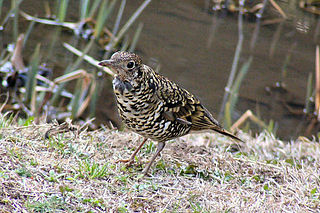 W
WThe Asian thrushes are medium-sized mostly insectivorous or omnivorous birds in the genus Zoothera of the thrush family, Turdidae. The genus name Zoothera comes from the Ancient Greek zoon, "animal" and theras, "hunter".
 W
WBrachypteryx is a genus of passerine birds containing six species known as shortwings, that occurs in southeast Asia.
 W
WDelichon is a small genus of passerine birds that belongs to the swallow family and contains three species named as house martins. These are chunky, bull-headed and short-tailed birds, blackish-blue above with a contrasting white rump, and with white or grey underparts. They have feathering on the toes and tarsi that is characteristic of this genus. The house martins are closely related to other swallows that build mud nests, particularly the Hirundo barn swallows. They breed only in Europe, Asia and the mountains of North Africa. Two species, the common and Asian house martins, migrate south in winter, while the Nepal house martin is resident in the Himalayas year-round.
 W
WEumyias is a genus of birds in the Old World flycatcher family Muscicapidae.
 W
WThe forktails are small insectivorous birds in the genus Enicurus. They were formerly in the thrush family, Turdidae, but are more often now treated as part of the Old World flycatcher family, Muscicapidae. Their name derives from their long forked tail.
 W
WThe laughingthrushes are a family of Old World passerine birds. They are diverse in size and coloration. These are birds of tropical areas, with the greatest variety in Southeast Asia and the Indian subcontinent. The entire family used to be included in the Timaliidae.
 W
WNiltava is a genus of passerine birds in the Old World flycatcher family Muscicapidae.
 W
WPardaliparus is a genus of birds in the tit family. The members of the genus were formerly included in Parus but were moved to Pardaliparus when Parus was split into several resurrected genera following the publication of a detailed molecular phylogenetic analysis in 2013.
 W
WPeafowl is a common name for three bird species in the genera Pavo and Afropavo of the family Phasianidae, the pheasants and their allies. Male peafowl are referred to as peacocks, and female peafowl as peahens, though peafowl of either sex are often referred to colloquially as "peacocks".
 W
WThe Phasianidae are a family of heavy, ground-living birds, which includes pheasants, partridges, junglefowl, chickens, turkeys, Old World quail, and peafowl. The family includes many of the most popular gamebirds. The family is a large one, and is occasionally broken up into two subfamilies, the Phasianinae and the Perdicinae. Sometimes, additional families and birds are treated as part of this family. For example, the American Ornithologists' Union includes the Tetraonidae (grouse), Numididae (guineafowl), and Meleagrididae (turkeys) as subfamilies in Phasianidae.
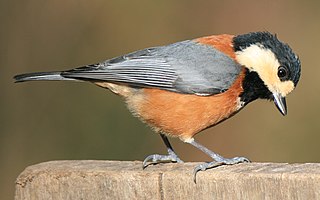 W
WSittiparus is a genus of birds in the tit family Paridae. The species in the genus were formerly included in Parus but were moved to Sittiparus when Parus was split into several resurrected genera following the publication of a detailed molecular phylogenetic analysis in 2013. The genus Sittiparus had originally been erected by the Belgium politician and naturalist Edmond de Sélys Longchamps in 1884 with the varied tit as the type species.
 W
WThe spiderhunters are birds of the genus Arachnothera, part of the sunbird family Nectariniidae. The genus contains thirteen species found in the forests of south and southeastern Asia. They are large representatives of the sunbird family, with drab plumage and long strongly curved bills. They feed on both nectar and a range of small arthropods.
 W
WTarsiger is a genus of six species of birds in the family Muscicapidae. They are small, mostly brightly coloured insectivorous birds native to Asia and northeastern Europe; four of the six species are confined to the Sino-Himalayan mountain system. The genus has sometimes been included within the related genus Luscinia, but the species have been found to form a distinct monophyletic group.
 W
WTragopan is a bird genus in the family Phasianidae, which is commonly called "horned pheasant" because males have two brightly colored, fleshy horns on their head that can be erected during courtship displays. The habit of tragopans nesting in trees is unique among phasianids. The scientific name refers to the horn, being a composite of tragos and the ribald half-goat deity Pan.
 W
WThe whistling thrushes comprise a genus Myophonus (Myiophoneus) of the Old World flycatcher family Muscicapidae.
 W
WThe East Asian–Australasian Flyway is one of the world's great flyways. At its northernmost it stretches eastwards from the Taimyr Peninsula in Russia to Alaska. Its southern end encompasses Australia and New Zealand. Between these extremes the Flyway covers much of eastern Asia, including China, Japan, Korea, South-East Asia and the western Pacific. It is especially important for the millions of migratory waders or shorebirds that breed in northern Asia and Alaska and spend the non-breeding season in South-East Asia and Australasia. In total, the flyway passes through 22 countries with approximately 55 migratory species travelling along it, equating to about 5 million birds.
 W
WThe pompadour green pigeon is a pigeon species complex. It is widespread in forests of southern and southeast Asia. Many authorities have split the pompadour green pigeon into multiple species, which are listed below:
 W
WThe Central Asian Flyway (CAF), Central Asian-Indian Flyway, or Central Asian-South Asian Flyway is a flyway covering a large continental area of Eurasia between the Arctic Ocean and the Indian Ocean and the associated island chains. The CAF comprises several important migration routes of waterbirds, most of which extend from the northernmost breeding grounds in Siberia to the southernmost non-breeding wintering grounds in West Asia, India, the Maldives and the British Indian Ocean Territory.
 W
WThe alpine accentor is a small passerine bird in the family Prunellidae.
 W
WThe Alpine chough, or yellow-billed chough, is a bird in the crow family, one of only two species in the genus Pyrrhocorax. Its two subspecies breed in high mountains from Spain eastwards through southern Europe and North Africa to Central Asia and Nepal, and it may nest at a higher altitude than any other bird. The eggs have adaptations to the thin atmosphere that improve oxygen take-up and reduce water loss.
 W
WThe Asian emerald cuckoo is a species of cuckoo in the family Cuculidae. It is found in Bangladesh, Bhutan, Cambodia, China, India, Indonesia, Laos, Malaysia, Myanmar, Nepal, Sri Lanka, Thailand, and Vietnam. Its natural habitats are subtropical or tropical moist lowland forests and subtropical or tropical moist montane forest.
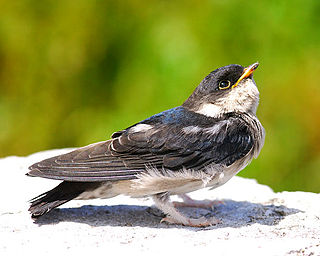 W
WThe Asian house martin is a migratory passerine bird of the swallow family Hirundinidae. It has mainly blue-black upperparts, other than its white rump, and has pale grey underparts. Its three subspecies breed in the Himalayas and in central and eastern Asia, and spend the winter lower in the mountains or in Southeast Asia. This species is locally abundant and is expanding northward in Siberia, so there are no concerns about its conservation status.
 W
WThe Asian stubtail is a bird in the family Cettiidae. The species was first described by Robert Swinhoe in 1863. It breeds in Korea, Manchuria and Japan and winters to southern China and northern Southeast Asia. Its natural habitat is temperate forest.
 W
WThe brambling is a small passerine bird in the finch family Fringillidae. It has also been called the cock o' the north and the mountain finch. It is widespread and migratory, often seen in very large flocks.
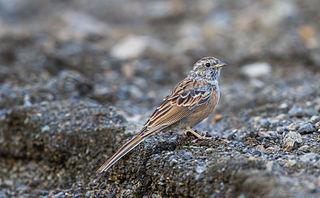 W
WGodlewski's bunting is a species of bird in the family Emberizidae. It is named after the Polish collector Victor Godlewski who obtained a specimen of which on the basis of which it was described by Taczanowski.
 W
WThe pine bunting is a passerine bird in the bunting family Emberizidae, a group most modern authors now separate from the finches, Fringillidae. It lives in Eurosiberia east of the Urals.
 W
WThe common buzzard is a medium-to-large bird of prey which has a large range. A member of the genus Buteo, it is a member of the family Accipitridae. The species lives in most of Europe and extends its breeding range across the Palearctic as far as the Russian Far East, northwestern China and northwestern Mongolia Over much of its range, it is a year-round resident. However, buzzards from the colder parts of the Northern Hemisphere as well as those that breed in the eastern part of their range typically migrate south for the northern winter, many culminating their journey as far as South Africa. The common buzzard is an opportunistic predator that can take a wide variety of prey, but it feeds mostly on small mammals, especially rodents such as voles. It typically hunts from a perch. Like most accipitrid birds of prey, it builds a nest, typically in trees in this species, and is a devoted parent to a relatively small brood of young. The common buzzard appears to be the most common diurnal raptor in Europe, as estimates of its total global population run well into the millions.
 W
WThe Oriental cuckoo or Horsfields cuckoo is a bird belonging to the genus Cuculus in the cuckoo family Cuculidae. It was formerly classified as a subspecies of the Himalayan cuckoo, with the name 'Oriental cuckoo' used for the combined species. Differences in voice and size suggest that it should be treated as a separate species. The binomial name Cuculus horsfieldi has often been used instead of Cuculus optatus, but is now usually considered to be a junior synonym.
 W
WThe brown dipper, also known as Pallas's dipper, Asian dipper or the Asiatic dipper, is an aquatic songbird found in the mountains of the east Palearctic. It is a thrush-like bird with a cocked tail. Its plumage is chocolate-brown with a slightly lighter coloured back and breast. At 22 cm (8.7 in) and 87 g (3.1 oz), it is the largest of the dippers. This species, which is not often seen, is found at medium to low elevations where mountain streams flow.
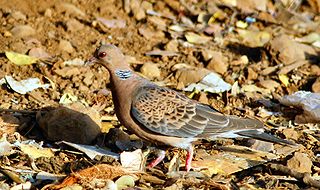 W
WThe oriental turtle dove or rufous turtle dove is a member of the bird family Columbidae. The species has a wide native distribution range from Europe, east across Asia to Japan. The populations show variations in the patterning of plumage and have been designated into at least six named subspecies. Populations in the higher latitudes tend to migrate south in winter while those closer to the tropics are sedentary. Vagrants have been recorded in North America. The species is predominantly granivorous and forages on the ground.
 W
WThe Asian dowitcher is a rare medium-large wader.
 W
WThe black drongo is a small Asian passerine bird of the drongo family Dicruridae. It is a common resident breeder in much of tropical southern Asia from southwest Iran through India, Bangladesh and Sri Lanka east to southern China and Indonesia and accidental visitor of Japan. It is an all black bird with a distinctive forked tail and measures 28 cm (11 in) in length. It feeds on insects, and is common in open agricultural areas and light forest throughout its range, perching conspicuously on a bare perch or along power or telephone lines. The species is known for its aggressive behaviour towards much larger birds, such as crows, never hesitating to dive-bomb any bird of prey that invades its territory. This behaviour earns it the informal name of king crow. Smaller birds often nest in the well-guarded vicinity of a nesting black drongo. Previously grouped along with the African fork-tailed drongo, the Asian forms are now treated as a separate species with several distinct populations.
 W
WThe eastern cattle egret is a species of heron found in the tropics, subtropics and warm temperate zones. Most taxonomic authorities lump this species and the western cattle egret together as subspecies of the cattle egret, but some separate them. Despite the similarities in plumage to the egrets of the genus Egretta, it is more closely related to the herons of Ardea. It is native to southern and eastern Asia, and Australasia.
 W
WThe peregrine falcon, also known as the peregrine, and historically as the duck hawk in North America, is a widespread bird of prey (raptor) in the family Falconidae. A large, crow-sized falcon, it has a blue-grey back, barred white underparts, and a black head. The peregrine is renowned for its speed, reaching over 320 km/h (200 mph) during its characteristic hunting stoop, making it the fastest bird in the world, as well as the fastest member of the animal kingdom. According to a National Geographic TV program, the highest measured speed of a peregrine falcon is 389 km/h (242 mph). As is typical for bird-eating raptors, peregrine falcons are sexually dimorphic, with females being considerably larger than males. Peregrine falcons have a flicker fusion frequency of 129 Hz, very fast for a bird of its size, and much faster than mammals.
 W
WThe Asian brown flycatcher is a small passerine bird in the flycatcher family Muscicapidae. The word Muscicapa comes from the Latin musca, a fly and capere, to catch. The specific dauurica refers to Dauria, an area of south-eastern Siberia named after a local nomadic tribe.
 W
WThe bean goose is a goose that breeds in northern Europe and Eurosiberia. It has two distinct varieties, one inhabiting taiga habitats and one inhabiting tundra. These are recognised as separate species by the American Ornithologists' Union and the IOC, but are considered a single species by other authorities, such as the British Ornithologists' Union. It is migratory and winters further south in Europe and Asia.
 W
WThe swan goose is a large goose with a natural breeding range in inland Mongolia, northernmost China, and southeastern Russia. It is migratory and winters mainly in central and eastern China. Vagrant birds are encountered in Japan and Korea, and more rarely in Kazakhstan, Laos, coastal Siberia, Taiwan, Thailand and Uzbekistan.
 W
WThe Chinese grouse, also known as Severtzov's grouse or the black-breasted hazel grouse is a grouse species closely related to the hazel grouse.
 W
WThe hazel grouse, sometimes called the hazel hen, is one of the smaller members of the grouse family of birds. It is a sedentary species, breeding across the Palearctic as far east as Hokkaido, and as far west as eastern and central Europe, in dense, damp, mixed coniferous woodland, preferably with some spruce.
 W
WThe hawfinch is a passerine bird in the finch family Fringillidae. Its closest living relatives are the evening grosbeak from North America and the hooded grosbeak from Central America and Mexico.
 W
WThe striated heron also known as mangrove heron, little heron or green-backed heron, is a small heron, about 44 cm tall. Striated herons are mostly non-migratory and noted for some interesting behavioral traits. Their breeding habitat is small wetlands in the Old World tropics from west Africa to Japan and Australia, and in South America and the Caribbean. Vagrants have been recorded on Oceanic islands, such as Chuuk and Yap in the Federated States of Micronesia, the Marianas and Palau; the bird recorded on Yap on February 25, 1991, was from a continental Asian rather than from a Melanesian population, while the origin of the bird seen on Palau on May 3, 2005 was not clear.
 W
WThe collared kingfisher is a medium-sized kingfisher belonging to the subfamily Halcyoninae, the tree kingfishers. It is also known as the white-collared kingfisher or mangrove kingfisher. It has a wide range extending from the Red Sea across southern Asia to Polynesia. A number of subspecies and subspecies groups have been split from this species including the Pacific kingfisher, the islet kingfisher, the Torresian kingfisher, the Mariana kingfisher, and the Melanesian kingfisher.
 W
WThe Asian koel is a member of the cuckoo order of birds, the Cuculiformes. It is found in the Indian Subcontinent, China, and Southeast Asia. It forms a superspecies with the closely related black-billed koels, and Pacific koels which are sometimes treated as subspecies. The Asian koel like many of its related cuckoo kin is a brood parasite that lays its eggs in the nests of crows and other hosts, who raise its young. They are unusual among the cuckoos in being largely frugivorous as adults. The name koel is echoic in origin with several language variants. The bird is a widely used symbol in Indian poetry.
 W
WThe common pheasant is a bird in the pheasant family (Phasianidae). The genus name comes from Latin phasianus, "pheasant". The species name colchicus is Latin for "of Colchis", a country on the Black Sea where pheasants became known to Europeans. Phasianus diverged from the genus Gallus, the genus of junglefowl and domesticated chickens, about 20 million years ago.
 W
WThe olive-backed pipit is a small passerine bird of the pipit (Anthus) genus, which breeds across southern, north central and eastern Asia, as well as in the north-eastern European Russia. It is a long-distance migrant moving in winter to southern Asia and Indonesia. Sometimes it is also called Indian pipit or Hodgson's pipit, as well as tree pipit owing to its resemblance with the tree pipit. However, its back is more olive-toned and less streaked than that species, and its head pattern is different with a better-marked supercilium.
 W
WRichard's pipit is a medium-sized passerine bird which breeds in open grasslands in the East Palearctic. It is a long-distance migrant moving to open lowlands in the Indian subcontinent and Southeast Asia. It is a rare but regular vagrant to western Europe.
 W
WThe lesser sand plover is a small wader in the plover family of birds. The spelling is commonly given as lesser sand-plover, but the official British Ornithologists' Union spelling is "lesser sand plover". The genus name Charadrius is a Late Latin word for a yellowish bird mentioned in the fourth-century Vulgate. It derives from Ancient Greek kharadrios a bird found in ravines and river valleys. The specific mongolus is Latin and refers to Mongolia which at the time of naming referred to a larger area than the present country.
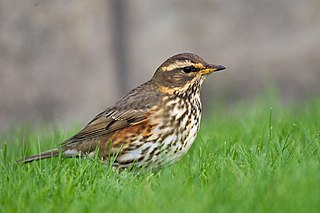 W
WThe redwing is a bird in the thrush family, Turdidae, native to Europe and the Palearctic, slightly smaller than the related song thrush.
 W
WThe common shelduck is a waterfowl species of the shelduck genus, Tadorna. It is widespread and common in the Euro-Siberian region of the Palearctic, mainly breeding in temperate and wintering in subtropical regions; in winter, it can also be found in the Maghreb. Its scientific name comes from the French name Tadorne for this species. It may originally derive from Celtic roots meaning "pied waterfowl", essentially the same as the English "shelduck".
 W
WThe brown shrike is a bird in the shrike family that is found mainly in Asia. It is closely related to the red-backed shrike and isabelline shrike. The genus name, Lanius, is derived from the Latin word for "butcher", and some shrikes are also known as "butcher birds" because of their feeding habits. The specific cristatus is Latin for "crested", used in a broader sense than in English. The common English name "shrike" is from Old English scríc, "shriek", referring to the shrill call.
 W
WThe Himalayan snowcock is a snowcock in the pheasant family Phasianidae found across the Himalayan ranges and parts of the adjoining Pamir range of Asia. It is found on alpine pastures and on steep rocky cliffs where they will dive down the hill slopes to escape. It overlaps with the slightly smaller Tibetan snowcock in parts of its wide range. The populations from different areas show variations in the colouration and about five subspecies have been designated. They were introduced in the mountains of Nevada in the United States in the 1960s and a wild population has established in the Ruby Mountains.
 W
WStejneger's stonechat is a species of stonechat native to eastern Asia. It breeds in central and eastern Siberia, Japan, Korea, northeastern China, and eastern Mongolia, and migrates south to southern China and Indochina in winter.
 W
WThe mute swan is a species of swan and a member of the waterfowl family Anatidae. It is native to much of Eurosiberia, and the far north of Africa. It is an introduced species in North America – home to the largest populations outside of its native range – with additional smaller introductions in Australasia and southern Africa. The name 'mute' derives from it being less vocal than other swan species. Measuring 125 to 170 cm in length, this large swan is wholly white in plumage with an orange beak bordered with black. It is recognisable by its pronounced knob atop the beak, which is larger in males.
 W
WThe greater crested tern, also called crested tern or swift tern, is a tern in the family Laridae that nests in dense colonies on coastlines and islands in the tropical and subtropical Old World. Its five subspecies breed in the area from South Africa around the Indian Ocean to the central Pacific and Australia, all populations dispersing widely from the breeding range after nesting. This large tern is closely related to the royal and lesser crested terns, but can be distinguished by its size and bill colour.
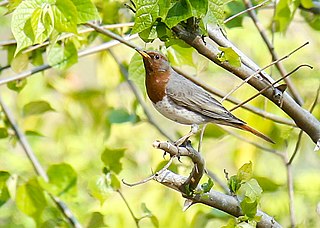 W
WThe red-throated thrush is a passerine bird in the thrush family. It is sometimes regarded as one subspecies of a polytypic species, "dark-throated thrush", black-throated thrush then being the other subspecies. More recent treatments regard the two as separate species. The scientific name comes from Latin. Turdus is "thrush" and the specific ruficollis is derived from rufus', "red", and collum, "neck".
 W
WOld World vultures are vultures that are found in the Old World, i.e. the continents of Europe, Asia and Africa, and which belong to the family Accipitridae, which also includes eagles, buzzards, kites, and hawks.
 W
WHume's leaf warbler or Hume's warbler is a small leaf warbler which breeds in the mountains of inner Asia. This warbler is migratory and winters mainly in India.
 W
WThe grey-capped pygmy woodpecker is an Asian bird species of the woodpecker family (Picidae). It has a subspecies, Yungipicus canicapillus doerriesi, located primarily in Manchuria, eastern Siberia, and Korea. Some taxonomic authorities continue to place this species in the genus Dendrocopos or Picoides.